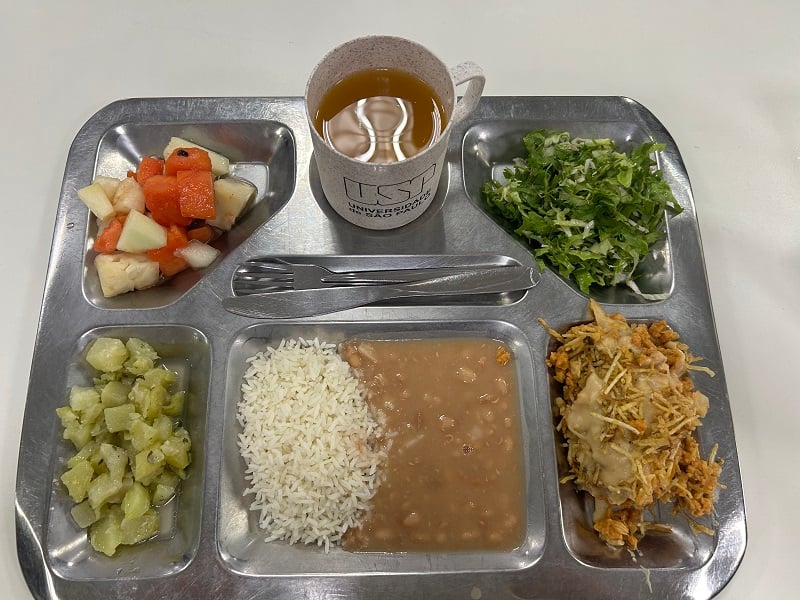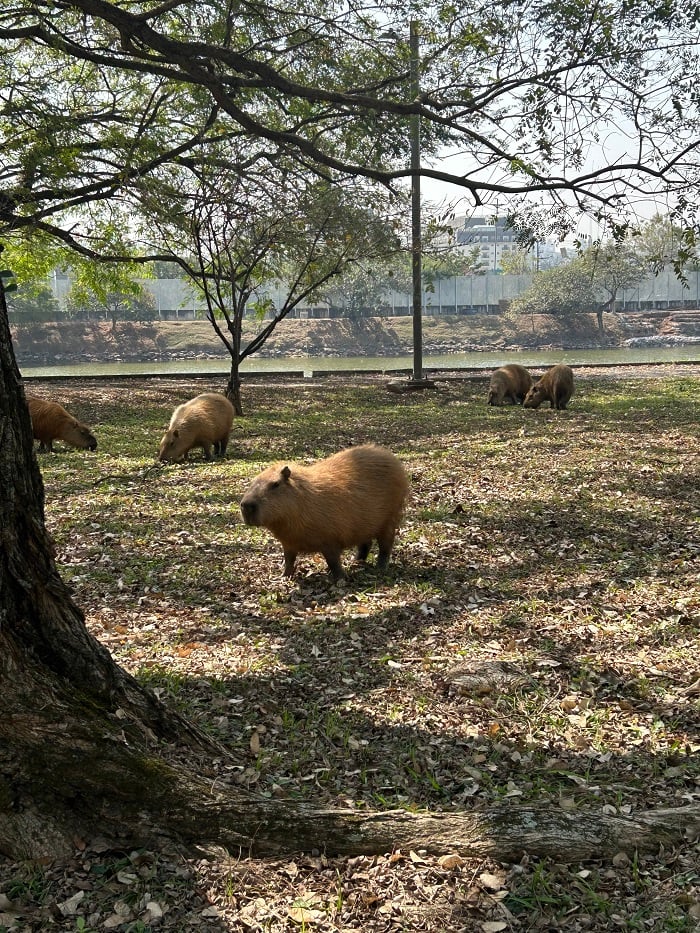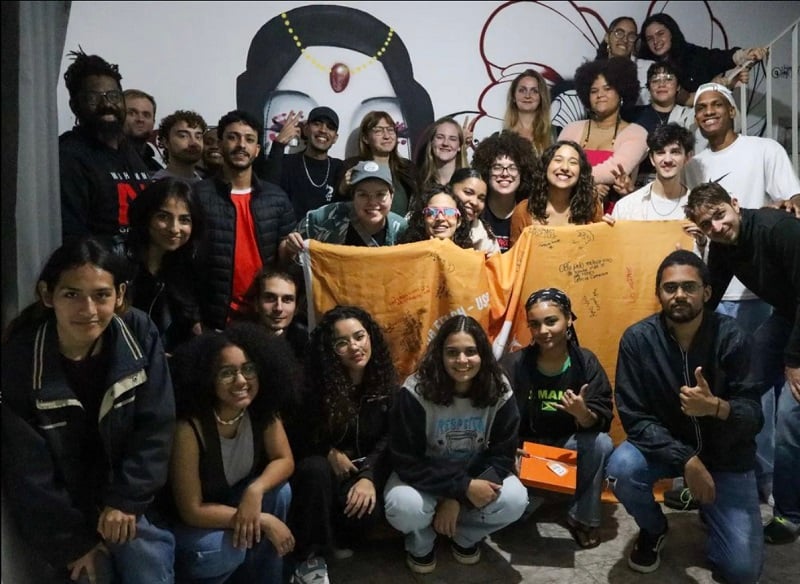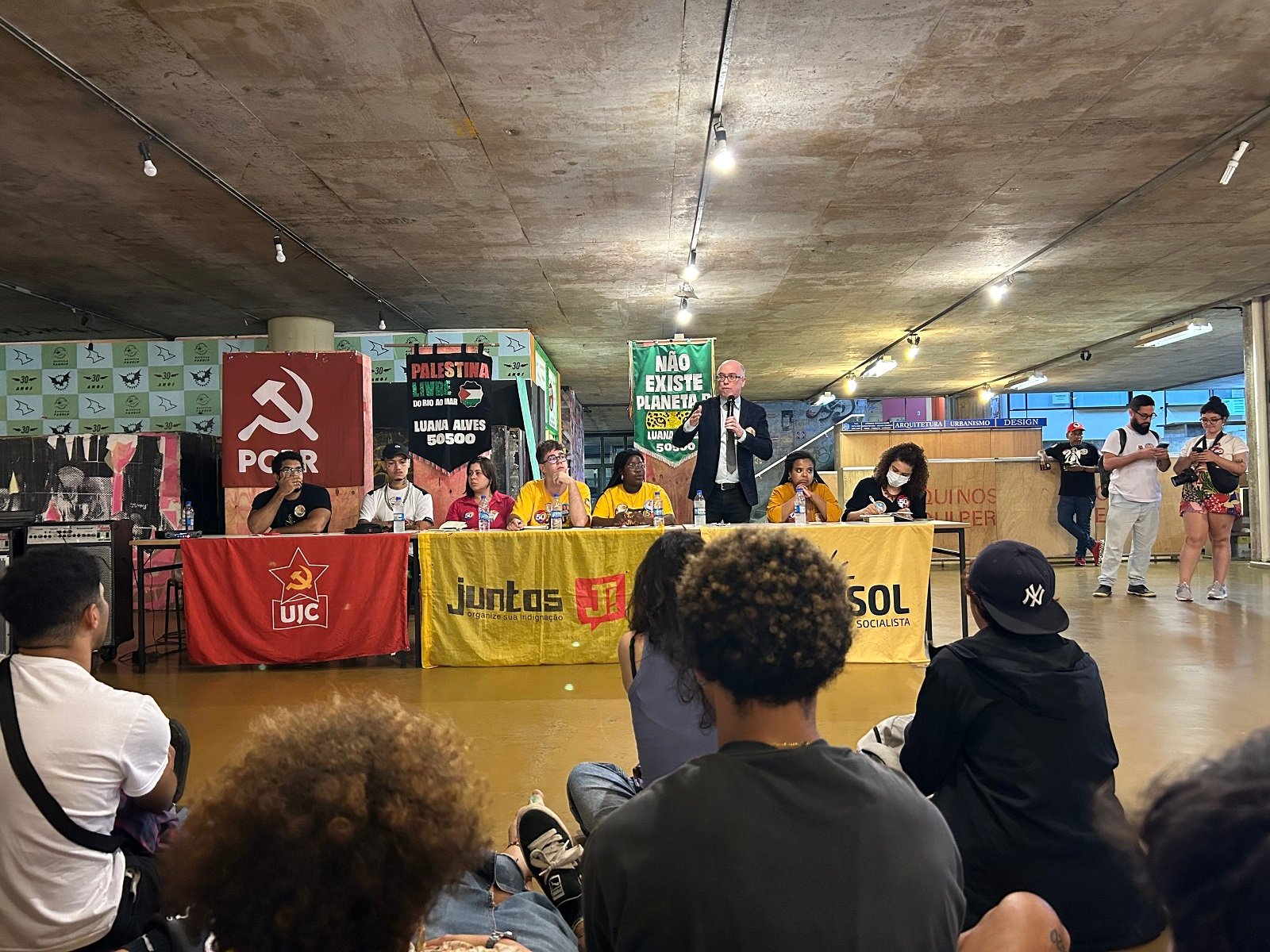Written by Martha Denton, (University of Minnesota), Student Correspondent for CET Brazil, (USP track), Fall 2024
When I first learned about the University of São Paulo in my first Portuguese class in Minnesota, it sounded like a dream. USP (pronounced oo-spee) is public and therefore tuition-free, the highest ranking university in Latin America, the largest university in Brazil with over 90,000 students across 7 campuses, an international research powerhouse, and an important cultural reference for Brazilians. When the opportunity arose to do an exchange semester at USP, I jumped on it. I’ve spent the past two and a half months studying in the Faculty of Philosophy, Languages and Human Sciences (FFLCH) , one of the 42 colleges that make up the university. Since I’m a one-person inaugural cohort of CET’s USP Direct-Enroll track, I thought I would take some time to explain what a typical day is like.
6:50am: Take the bus to campus
My classes are all on the Butantã campus, about a 50-minute bus ride from my apartment. Since I already spent an entire post hyping up São Paulo’s transit system, I’ll spare you the details. Sometimes I leave a bit earlier to stop in the bandejão (cafeteria) for a breakfast of café com pão (bread and coffee) and fruit which is the classic Brazilian breakfast, the cultural equivalent of bacon and eggs in America. I have two 8am classes every week, but if you’re not a morning person, there are plenty of afternoon and evening classes to choose from. It’s actually more common for students to take evening classes than daytime classes, since the majority of Brazilian students work full-time in addition to studying.
8:00am: Attend class
Thankfully, I had a two-week period to attend different classes before registering, so I could pick classes that are both interesting and manageable for a non-native speaker. I landed on Urban Geography, Variationist Sociolinguistics, and Comparative Studies in Lusophone Literatures. I’m particularly enjoying my urban geography class, where I’ve been able to engage with Brazilian urbanism theoretically by studying the “right to the city”, as well as practically through a project analyzing maps and data from an assigned district in São Paulo. It can be intimidating to be the only exchange student in a class of 40-50 people, but I’ve found my professors to be very welcoming and often go out of their way to explain when someone uses an unusual word that I’m not likely to have encountered.
The academic culture in Brazil is quite different from the American classes I’m used to. In some ways, Brazilian classes are more formal, in that they are more lecture-based and have more academic readings that accompany the classes. A final paper often constitutes most or all of the grade, and it’s very uncommon to be graded on participation. In other ways, classes are more informal, in that professors might communicate with the class through WhatsApp, and it doesn’t seem to be considered very disrespectful to walk into class 30-40 minutes late.
10:00am: Find a cozy study spot
After class, I like to find a quiet, comfortable place to do my readings or write papers. One of my favorite places to study is the geography building (not just because I’m a geography student). The building has an open design, without a clear division between inside and outside. While this would be miserable in blizzardy Minnesota winters, in toasty São Paulo it’s quite pleasant. The classrooms have enormous windows looking out on tropical greenery–sometimes I feel like I’m in a botanical garden that happens to have classrooms. The geography building is also surrounded by lanchonetes (snack bars) that sell salgados (savory pastries) which is great for getting a snack while taking a break from studying.

In an effort to go beyond FFLCH, I’ve been working my way through this list of study spaces on campus. I particularly like the soft chairs and enormous windows of the Biblioteca Brasiliana, the art covered brutalist architecture of the College of Architecture and Urbanism (FAU), and the tidiness of the math library. One difference from the U.S. is that most libraries here require you to store everything but your study materials in a locker before entering. The wifi can be a bit spotty on campus, but I’ve found the Inova USP-Cosmos co-working space is a very reliable place to take a Zoom meeting if needed.
11:15am: Eat lunch in the bandejão
One of the perks of being at a public university is that the food is subsidized, so you can get a filling and tasty meal for only R$2 (~$0.36 USD)! There is debate about which one of the four bandejões (cafeterias) serves the best food. After trying all four, I can confirm the Bandejão Central consistently has the most delicious food, while the Bandejão das Químicas comes in second place for having shorter lines and occasional standout meals. I’m grateful to have extremely inexpensive and healthy food available, since it means I don’t need to prepare lunches to bring to campus like at home. I try to get there when they open at 11:15am to beat the line, which depending on the time, location, and popularity of dishes being served can take up to 40 minutes.

At lunch and dinner the options always include rice and beans (a Brazilian staple), a meat-based main dish (or a vegetarian option, which I appreciate), a side dish, some kind of salad, bread, and dessert. And the best part (in my opinion): unlimited juice with a rotation of passion fruit, tangerine, guava, grape, apple, and mango juice. The one catch is you have to bring your own cup. I heard that during the pandemic, juice was cut to reduce costs, and students were understandably upset.
12:00pm: Study some more
While the number of assignments per class is much lower than what I’m used to in the U.S. and my classes only meet once per week, I still spend a significant part of my week studying. As a non-native speaker, it takes me longer to do the readings, and I like to look up the words I don’t know to learn new vocabulary and make sure I’m understanding the content. The conversion from Brazilian to American grades is not particularly forgiving, so there’s also some extra pressure to do my best.
One helpful aspect of the program is that it starts with a two-week Portuguese intensive. My course included conversations about Brazilian academic norms, feedback to improve my pronunciation and writing, readings from important Brazilian intellectuals like Sérgio Buarque de Holanda and Gilberto Freyre, and a final paper written using ABNT (the Brazilian citation style). My instructor Giselda was incredible and even showed me the bus route to campus and gave me a tour before my first day of class. She studied at USP and has worked with exchange students from around the world, so she had lots of helpful advice about navigating the new academic environment.
4:00pm: Explore a new part of campus
I make it a goal to explore at least one new part of the USP campus every week. After two months, I’ve still only seen a fraction since the Cidade Universitária (college town) is 3,650,000 m² or 1.4 mi2. Some of my favorite adventures have been walking along the Raia Olímpica (Olympic rowing lane) to see the adorable capybaras which are cared for by the veterinary school.

I also enjoy seeing movies at CINUSP, a free movie theater that has two showings a day of art house as well as more mainstream films with a new theme every month. It’s been a film-filled semester, because in addition to CINUSP and my Brazilian Cinema class at CET, I’ve also started going to a Cineclube, which is a student organized movie club that meets weekly to watch and discuss films.
I also paid a visit to the Biology Museum at Instituto Butantan, an enormous research right outside campus, where I saw all sorts of Brazilian reptiles and lizards. Later in the semester, I’m excited to explore more of USP’s many museums, like the Archeology Museum and the Education Museum.
6:00pm: Dinner with friends
Around 6:00pm, I head back to the bandejão for a meal with friends from class or other exchange students. Since most Brazilian college students work full-time in addition to class and often live 1-2 hours from campus, it can be hard to spend time together outside of class. But I’ve found a few groups of friends that I consistently have dinner with or study together between classes. I’ve found my classmates are very friendly and curious about my experience coming from the United States. In addition to chatting in person, they’ve also helped me expand my repertoire of figurinhas (WhatsApp memes), which Brazilians have mastered the art of creating and sending.

While I’m the only American in my college this semester, I’ve made exchange student friends from Germany, France, Chile, Spain, Italy and beyond who are also navigating a new academic culture in a different language, so it’s been helpful to trade advice and experiences. USP has a student group called InGloba, which has a goal of internationalizing the university by planning events for exchange students and Brazilians. So far they’ve organized events like a campus tour, potluck, and language exchange.
7:00pm: Attend an event
After dinner, I often attend a campus event before heading home. Last week, I went to a panel about the effects of the climate crisis and the far right, with speakers including an USP professor and a city councilor. In general, the USP community is very politically engaged and at the forefront of important political changes like the fight for climate action, trans rights, an end to gender based violence, and Palestinian liberation. It’s common for students to walk into classrooms and politely pause class to share announcements about upcoming rallies and pass around petitions. During the Brazilian military dictatorship between 1964-1985, USP students played a central role in the resistance. I learned that to this day, the military police are not allowed on campus without university approval.

As a geography major, I’ve also enjoyed getting more involved with USP’s geography department. Since the department is celebrating its 90th anniversary, there has been a great lecture series about the history of the department. I went to one panel about women in geography at USP and another about renowned Brazilian geographer Aziz Ab’Sáber and his discoveries in environmental geography. Last week I also attended an incredible abolitionist geography conference which had one of my favorite American geographers, Ruth Wilson Gilmore, as the keynote speaker!
8:00pm: Head back home
Finally, I take the bus home to get a good night’s sleep. Spending 10-12 hours a day fully immersed in Brazilian academic life can be very tiring, but I can feel my Portuguese improving every day. It is a huge privilege to study at USP and experience life as a college student in Brazil. My time at USP–the classes I’m taking, the friends I’ve made, and the places I’ve explored–has been the highlight of my time in São Paulo.
Source link
All Materials on this website/blog are only for Learning & Educational purposes. It is strictly recommended to buy the products from the original owner/publisher of these products. Our intention is not to infringe any copyright policy. If you are the copyright holder of any of the content uploaded on this site and don’t want it to be here. Instead of taking any other action, please contact us. Your complaint would be honored, and the highlighted content will be removed instantly.
